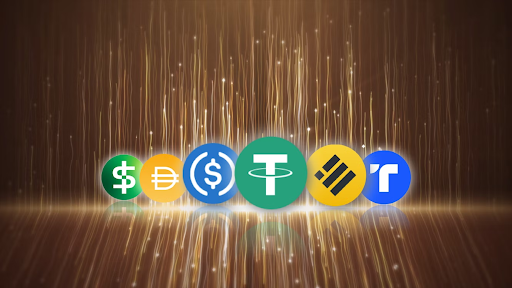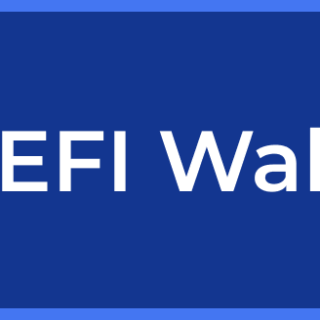Best Stablecoins & Types of Stablecoin (2023)
What are stablecoins?
Stablecoins are cryptocurrency tokens which are designed to be pegged to another asset, usually a fiat currency like the United States Dollar (USD). By design, the stablecoin prices are meant to provide a stable alternative medium of exchange for crypto investors compared to cryptocurrencies that have a high amount of volatility in prices.
There are opportunities for stablecoin staking, both on centralized (CeFi) and decentralized (DeFi) platforms to earn yield. Stablecoins are available in most of the smart contract blockchains, e.g. Ethereum, Binance Smart Chain, Avalanche, Cosmos ecosystem, TRON, Algorand, Layer 2s and others.
In this article we will explore:
- Stablecoin News and Dominance
- Best stablecoins to utilize now
- Different types of stablecoins
- How to earn interest by staking stablecoins
- Risks of stablecoins
Crypto News from Messari mentions that the total size of the Stablecoin market is just north of 150$ billion at the end of Sept 2022. In recent weeks, USD Coin (USDC) is losing market share to USDT and BUSD in correlation with Binance and other major Centralized Exchanges delisting USDC as the base stablecoin pair and replacing it with BUSD.
It seems the best stablecoins just based on market cap and demand are fiat-backed stablecoins such as USDC, USDT, and BUSD.
Crypto News from Glassnode and Will Clemente notes that since 2020 USDT has dropped from 88% to 48%, USDC has tripled its market share from 10% to 32%, and BUSD has grown about 30x from 0.5% to 15%.
Regulation for Stablecoins is a hot topic within the crypto space. The U.S. Department of the Treasury stated that the implications of stablecoins and their payment systems is difficult to predict and therefore difficult to regulate.
Specifically the riskier algorithmic stablecoins have been allowed to grow exponentially, however with the recent crash of the Terra ecosystem including UST, its algorithmic stablecoin, regulators are now on high alert. Stablecoin regulation is coming to the space and many would like to see clarity on the rules of stablecoins.
Best Stablecoins to Utilize Now
Fiat-backed stablecoin
- Tether (USDT)
- USD Coin (USDC)
- Binance USD (BUSD)
- True USD (TUSD)
- Paxos Standard (PAX)
- Gemini USD (GUSD)
- Huobi USD (HUSD)
Crypto-backed stablecoin
- Dai (DAI)
- Kujira USK (USK)
Algorithmic stablecoin
- Neutrino USD (USDN)
- Decentralized USD (USDD)
- Fei USD (FEI)
- Magic Internet Money (MIM)
- Frax (FRAX)
- Ampleforth (AMPL)
Commodity backed stablecoins
- PAX Gold (PAXG)
- Tether Gold (XAUT)
What types of stablecoins are there?
Fiat-backed stablecoins
This is one of the most common types of stablecoins, where a centralized entity accepts several different fiat currencies and mint the stablecoins. Examples include USDT (also known as Tether) which currently has the largest market cap among all stablecoins.
Here, a customer can use fiat to buy USDT from Tether Operations Ltd., or sell USDT back to fiat. Tether then commits to always have sufficient fiat to account for every USDT that they issue. Other examples of fiat-backed stablecoins are USD Coin (USDC), BUSD and many others.
Crypto-backed stablecoin
Crypto-backed stablecoins are another form of stablecoin that are collateralized with another crypto asset instead of fiat. One of the first and most successful was the DAI stablecoin from the decentralized MakerDAO protocol.
Users can deposit ETH and mint DAI using their over-collateralized ETH deposits. The value of DAI is then soft-pegged to USD by redeeming DAI back to ETH (when DAI price is low) or minting more DAI (when price is high).
Algorithmic stablecoins
Algorithmic stablecoins are a newer form of stablecoin that has emerged recently that are mostly undercollateralized or even non-collateralized.
Due to the undercollateralized nature and design of this type of stablecoin, inherently algorithmic stablecoins are much riskier than a traditional collateralized stablecoin such as USD Coin (USDC), USDT, BUSD, or DAI mentioned above.
These stablecoins are called algorithmic because what backs them on-chain is an algorithm that changes the supply and demand between the stablecoin and another cryptocurrency that works together to maintain their pegs. The best stablecoin examples of this type include UST, MIM, FRAX, and USDN.
Seigniorage and Rebase-style stablecoins
These are different variants of algorithmic stablecoins. Seigniorage designs usually include a “bond token” which can be bought cheaper when the stablecoin is below peg, and can eventually be redeemed 1:1 when the stablecoin is repegged.
Rebase designs algorithmically adjust the total circulating supply of the stablecoins and automatically updates the number of tokens in each holders’ address.
Hybrid design stablecoins
With more stablecoin designs being developed, multiple protocols are now adopting hybrid designs. For example, the DAI MakerDAO protocol started with only ETH as the over-collateralized asset, though has since included other crypto backing assets like USDC.
Additionally, they are now considering the addition of fiat or tradfi assets as additional collateral, and therefore could evolve to be a crypto or fiat-backed hybrid.
Another example of a hybrid design is the FRAX stablecoin, which has both collateralized crypto assets plus an algorithmic design in conjunction with the FRX token.
Commodity backed stablecoins
Stablecoins do not necessarily have to be pegged to a fiat currency, but could be pegged to a commodity instead. The most famous of these would be PAXG and XAUT, which are pegged to and collateralized by gold reserves.
While commodity backed stablecoins are not as popular within the crypto space, these stablecoins are used as a way to access asset classes that were previously inaccessible to small investors.

Earning Interest on your Stablecoins / Stablecoin Staking
There are various avenues to earn yield or interest by staking your stablecoins. These stablecoin staking opportunities are a subset of the wider staking / yield earning opportunities for the wider cryptocurrency tokens.
Stablecoin rates from such stablecoin staking opportunities will vary depending upon the supply, demand, and design of the platform you are staking your stablecoins. Generally the higher stablecoin rates (APY %) involve higher risk strategies to produce large yields, while the lower stablecoin rates tend to be lower risk strategies to generate yield.
There are generally two types of stablecoin staking (CeFi vs DeFi), as described below:
Centralized platforms (CeFi)
Centralized exchanges (e.g. Binance, Gemini, Kraken) and other “savings” platforms (e.g. Nexo, BlockFi) have options for users to deposit stablecoins and earn interest, much like a savings account from a traditional bank. Usually, these platforms will utilize users’ deposits by lending or investing to obtain yield, a portion of which is given to depositors as interest.
Generally, it is difficult to obtain a fully transparent picture of how these platforms obtain their yields to pay for their advertised stablecoin rates. It is still prudent to assume that platforms which offer higher stablecoin rates may be less sustainable in their longer term operations.
Decentralized platforms (DeFi)
Decentralized options for earning yield with stablecoins include liquidity pools and lending. Liquidity pools (e.g. on THORChain, Uniswap, etc.) provide a decentralized way for trading, and some of the trading fees are given to the liquidity providers as yield.
Lending platforms (e.g. AAVE) are analogous to traditional lending, but administered via smart contract on blockchains. Here, borrowers will pay an interest rate for loans, and thus generating yield for the lenders.
One can find a large variance in the stablecoin rates offered on such DeFi platforms, which will depend on the specific stablecoin being staked and the specific DeFi protocol that is offering those stablecoin staking opportunities.
Again, be extra careful on newer, more experimental stablecoin staking platforms offering very high stablecoin rates.
Are stablecoin riskless?
Stablecoins are not without their own set of risks. Each type of stablecoin has its own set of pros and cons due the design of how the stablecoin maintains its peg.
The overarching risks of stablecoins include:
Lack of confidence: If a stablecoin is not sufficiently backed by the reserve currencies or assets, or the algorithm design was unable to preserve the peg, its possible that users will not be able to redeem their stablecoins for 1:1 value.
The best stablecoin example of this would be Terra (UST) which broke its peg in May 2022 when confidence for the algorithm re-pegging mechanism was lost causing a downward spiral towards zero in both the price of the stablecoin UST and the crypto asset LUNA.
Centralization risks: Although the cryptocurrency may seem decentralized, in reality you are essentially trusting that the parties maintaining the stablecoin are properly managing risk and security of the stablecoin. If the team is mismanaging the funds and can no longer back the asset to maintain its value, the stablecoin is at risk.
Additionally, centralized stablecoins such as USD Coin (USDC) and USDT have been frozen on several centralized exchanges and even on selected non-custodial addresses/contracts, due to exploiters moving stolen crypto in an attempt to clean the crypto, interacting with privacy mixers to obscure the origination of transactions through Tornado Cash, and other instances.
Security: Stablecoins also need to be stored in self-custody wallets such as XDEFI Wallet or on a centralized exchange such as Binance. This presents security risks as you are essentially trusting your own security practices if you are using a self-custody wallet or the security practices of a centralized entity.
There are always different vulnerabilities being presented in the space, so please be vigilant in practicing the highest security methods for your crypto.
CeFi/DeFi yield: When depositing stablecoins into CeFi platforms, the user is relinquishing control of those assets. If those CeFi platforms run into troubles, the user may be unable to withdraw or even lose their assets altogether, e.g. in the recent issues with Celcius, Voyager, Holdnaut, etc in mid 2022.
DeFi platforms also have risks, mainly smart contract bugs, or poor protocol design leading to exploits and loss of funds.
Summary:
In summary, although stablecoins have some of their own risks, they provide a stable alternative medium of exchange within the crypto space by maintaining the value in different ways. Due to the nature of stablecoins, they act as a great medium of currency to transact in for payments, collateral, and debt.
In addition to this, stablecoins can be used to earn interest in various centralized and decentralized platforms. The stablecoin market cap is roughly 150 billion dollars worth and this number continues to grow as different types of stablecoins are created and tested.
Finally, we come to the major question: what is the best stablecoin to invest in and earn yield on? From all the information above, there is no one-size-fits-all “best” stablecoin. Some users prefer the fiat-backed stablecoins which currently have the highest market cap, the deepest liquidity in and the highest number of trading pairs.
Some users prefer decentralized crypto-backed stablecoins to avoid centralization risks. Some users prefer to mint algorithmic stablecoins, instead of inefficiently depositing over-collateralized assets to mint crypto-backed stablecoins.
Finally, some users will prefer to hold any stablecoins which gives the highest interest APY from the myriad of both CeFi and DeFi opportunities available. As can be seen, it is useful as a crypto investor to learn which priorities you hold highest when considering which type or types of stablecoins you wish to invest in.





